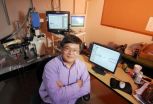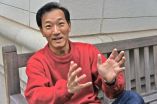(Press-News.org) In a new paper published Jan. 21 in the journal Science, a team of researchers led by Microbiology and Immunology professor Blossom Damania, PhD, has shown for the first time that the Kaposi sarcoma virus has a decoy protein that impedes a key molecule involved in the human immune response.
The work was performed in collaboration with W.R. Kenan, Jr. Distinguished Professor, Jenny Ting, PhD. First author, Sean Gregory, MS, a graduate student in UNC's Department of Microbiology and Immunology played a critical role in this work.
The virus-produced protein, called a homolog, binds to the cellular protein that normally triggers an inflammatory response, a key immune system weapon for fighting viral infection. However, the homolog lacks a key part of the cellular protein that triggers the inflammation process. Inflammasome activation leads to the production of proinflammatory cytokines and eventual cell death.
Damania compares the homolog's action to what can happen when completing a jigsaw puzzle. "Sometimes there will be a piece that 'almost' fits into an available space, but because it's not an exact fit, leaving it there will keep you from completing the puzzle. The viral homolog gums up the works, preventing the formation of a large complex called the inflammasome, and keeping the cell's immune response from deploying."
According to Damania, a cell's response to a viral invader is to commit suicide. The cells die rather than spread the virus, which uses the cell by hijacking its genetic machinery to produce more virus. Kaposi sarcoma virus' ability to evade the body's immune system helps it lie dormant and persist in the body over a lifetime.
Both researchers are members of UNC Lineberger Comprehensive Cancer Center. Dr. Damania studies the Kaposi's sarcoma virus, which is known to cause certain types of human cancer, because it can infect cells and lie dormant without triggering cellular death. Virus-infected cells then proliferate, and can give rise to cancer.
INFORMATION:
Damania and Ting's research collaborators include Sean Gregory, M.S., Beckley Davis, PhD, John West, PhD, and Debra Taxman, PhD, all of UNC Lineberger and the UNC Department of Microbiology and Immunology. Damania is also a member of the UNC Center for AIDS Research. Dr. Ting is the co-Director of the Inflammatory Disease Institute and Director of the Center for Translational Immunology. The team also included collaborators, John Reed, MD, and Shu-ichi Matsuzawa, PhD, both of the Sanford-Burnham Medical Research Institute in La Jolla, California.
The research was supported by the US National Institutes of Health, the University Cancer Research Fund, the American Heart Association, the Burroughs Wellcome Fund, and the Crohn's & Colitis Foundation of America. Damania is a Leukemia & Lymphoma Society Scholar and Burroughs Wellcome Fund Investigator in Infectious Disease.
END
VIDEO:
This video shows the micropipette adhesion frequency assay used to study the mechanical interactions between a T cell and an antigen presented on a red blood cell.
Click here for more information.
Researchers have for the first time mapped the complex choreography used by the immune system's T cells to recognize pathogens while avoiding attacks on the body's own cells.
The researchers found that T cell receptors – molecules located on the surface of the T cell ...
The discovery of an ancient fossil, nicknamed 'Mrs T', has allowed scientists for the first time to sex pterodactyls – flying reptiles that lived alongside dinosaurs between 220-65 million years ago.
Pterodactyls featured prominently in Spielberg's Jurassic Park III and are a classic feature of many dinosaur movies where they are often depicted as giant flying reptiles with a crest.
The discovery of a flying reptile fossilised together with an egg in Jurassic rocks (about 160 million years old) in China provides the first direct evidence for gender in these extinct ...
In 2008, an international team of scientists studying an exotic new superconductor based on the element ytterbium reported that it displays unusual properties that could change how scientists understand and create materials for superconductors and the electronics used in computing and data storage.
But a key characteristic that explains the material's unusual properties remained tantalizingly out of reach in spite of the scientists' rigorous battery of experiments and exacting measurements. So members of that team from the University of Tokyo reached out to theoretical ...
Scientists from the University of Leeds have made a fundamental step in the search for therapies for amyloid-related diseases such as Alzheimer's, Parkinson's and diabetes mellitus. By pin-pointing the reaction that kick-starts the formation of amyloid fibres, scientists can now seek to further understand how these fibrils develop and cause disease.
Amyloid fibres, which are implicated in a wide range of diseases, form when proteins misfold and stick together in long, rope-like structures. Until now the nature of the first misfold, which then causes a chain reaction of ...
The anti-diuretic hormone "vasopressin" is released from the brain, and known to work in the kidney, suppressing the diuresis. Here, the Japanese research team led by Professor Yasunobu OKADA, Director-General of National Institute for Physiological Sciences (NIPS), and Ms. Kaori SATO, a graduate student of The Graduate University for Advanced Studies, clarified the novel function of "vasopressin" that works in the brain, as well as in the kidney via the same type of the vasopressin receptor, to maintain the size of the vasopressin neurons. It might be a useful result for ...
Humans use their senses to help keep track of short intervals of time according to new research, which suggests that our perception of time is not maintained by an internal body clock alone.
Scientists from UCL (University College London) set out to answer the question "Where does our sense of time come from?" Their results show that it comes partly from observing how much the world changes, as we have learnt to expect our sensory inputs to change at a particular 'average' rate. Comparing the change we see to this average value helps us judge how much time has passed, ...
For centuries, some of the greatest names in math have tried to make sense of partition numbers, the basis for adding and counting. Many mathematicians added major pieces to the puzzle, but all of them fell short of a full theory to explain partitions. Instead, their work raised more questions about this fundamental area of math.
On Friday, Emory mathematician Ken Ono will unveil new theories that answer these famous old questions.
Ono and his research team have discovered that partition numbers behave like fractals. They have unlocked the divisibility properties of ...
SPOKANE, Wash.— Washington State University sleep researchers have determined that the air traffic controller in the crash of a Lexington, Ky., commuter flight was substantially fatigued when he failed to detect that the plane was on the wrong runway and cleared it for takeoff.
Writing in the journal Accident Analysis and Prevention, the researchers come short of saying his fatigue caused the accident. But they say their findings suggest that mathematical models predicting fatigue could lead to schedules that reduce the risk of accidents by taking advantage of workers' ...
The ESHRE Task Force on Ethics and Law acknowledges the benefits that IMAR may bring to those choosing this approach and concludes that certain forms of IMAR are morally acceptable under certain conditions. The group advises to evaluate each request for IMAR individually, based on four ethical principles in health care: the respect for autonomy, beneficence and non-maleficence and justice.
The Task Force explains that the right for individual autonomy is elementary: any individual should have the principle of choice with whom to reproduce. It is understandable that couples ...
Depending on the level of smoking and dietary vitamin C intake, vitamin E supplementation may extend the life-span of restricted groups of men, according to a study published in the Age and Ageing.
Several large randomized trials of humans found that vitamin E supplementation does not reduce mortality. However, the average effect on mortality in a group of people with a wide age range may mask an effect of vitamin E on the life-span.
Dr. Harri Hemila, and Professor Jaakko Kaprio, of the University of Helsinki, Finland, studied the age-dependency of vitamin E effect ...



